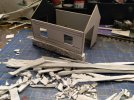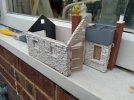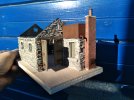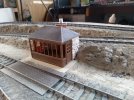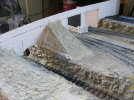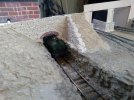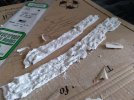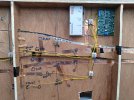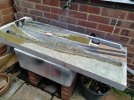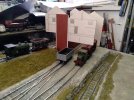Dave
Western Thunderer
Evening all,
I started to build this new micro layout a few months ago, so I thought I may as well start a thread about it.
Scale: 4mm
Dimensions: 4ft. x 18 ins. plus 18 in long FY.
Time Period: 1950s/60s
Location: Peak District.
It is a fictional location and company, somewhere around Wirksworth/Cromford/Matlock. A limestone processing plant that is connected to British Railways and to a distant quarry. I like to make life difficult for myself, so decided that the line to the quarry was originally narrow gauge and was converted to standard gauge during The Great War. This means the line has a tunnel with very restricted clearances and can only be worked by engines that have been specially adapted. The BR connection was put in by the Midland Railway and is of a conventional loading gauge.
Loads out consist of crushed limestone for use in steelmaking and as roadstone. This is carried in hoppers and tipplers. Limestone dust, for various uses including fire prevention in coal mines, leaves the site in Presflo and Covhop wagons.
The baseboard.
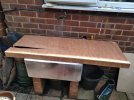
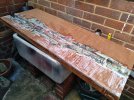
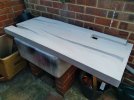
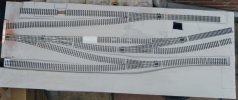
The FY bolts on to the LH end and the lowermost track goes to the quarry. The white patch on the run-round loop is the weighbridge and the hole in the baseboard near the top RH is where wagons of quarried stone will discharge. The top LH track is where the engine shed will be sited. The gap in the sleepers there is for an ash pit.
I started to build this new micro layout a few months ago, so I thought I may as well start a thread about it.
Scale: 4mm
Dimensions: 4ft. x 18 ins. plus 18 in long FY.
Time Period: 1950s/60s
Location: Peak District.
It is a fictional location and company, somewhere around Wirksworth/Cromford/Matlock. A limestone processing plant that is connected to British Railways and to a distant quarry. I like to make life difficult for myself, so decided that the line to the quarry was originally narrow gauge and was converted to standard gauge during The Great War. This means the line has a tunnel with very restricted clearances and can only be worked by engines that have been specially adapted. The BR connection was put in by the Midland Railway and is of a conventional loading gauge.
Loads out consist of crushed limestone for use in steelmaking and as roadstone. This is carried in hoppers and tipplers. Limestone dust, for various uses including fire prevention in coal mines, leaves the site in Presflo and Covhop wagons.
The baseboard.




The FY bolts on to the LH end and the lowermost track goes to the quarry. The white patch on the run-round loop is the weighbridge and the hole in the baseboard near the top RH is where wagons of quarried stone will discharge. The top LH track is where the engine shed will be sited. The gap in the sleepers there is for an ash pit.
Last edited:

